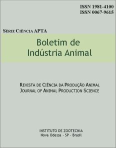Oxytetracycline e Virginiamycin in feeding of broilers
Abstract
The objective of this study was to verify the effect of oxytetracycline and virginiamycin when added to broilers feed. One thousand-two day-old broiler chicks were distributed into a floor pen, 30 of each sex per pen. Five treatments were replicated eight times and collected data were submitted to the analysis of variances according to the experimental design from randomized blocks. Experimental design was based on different treatments as follow: R1€” 110 ppm of oxytetracycline for starter ration and 55 ppm for finisher ration; R2 €” 10 ppm of virginiamycin for starter ration and 5 ppm for finisher ration; R3 €” 110 ppm ofoxytetracycline plus 10 ppm of virginiamycin for starter ration and 55 ppm of oxytetracycline plus 5 ppm of virginiamycin for finisher ration; R4 €” 20 ppm ofvirginiamycin for starter ration and 10 ppm for finisher ration; R5 €” control (non medicated). Based on the found results we can conclude that: a) oxytetracycline and virginiamycin didn€™t interfere in feed consumption and weight gain in all the studied periods (0 to 28, 29 to 49 and 0 to 49 days); b) during the period from 0 to 28 days, virginiamycin (both levels) had a significant effect on feed conversion when compared to the control group (P ‰¤ 0.05); however, there weren€™t significant differences on feed conversion from birds of other treatments; c) regarding weight gain, feed consumption and feed conversion, significant difference was not observed from 29 to 49 days among the different treatments; d) during the period from 0 to 49 days, the treatments R2 (10 ppm of virginiamycin for starter ration and 5 ppm for finisher ration) and R3 (110 ppm of oxytetracycline plus 10 ppm of virginiamycin for starter ration and 55 ppm of oxytetracycline plus 5 ppm of virginiamycin for finisher ration), showed significant differences (P ‰¤ 0.05) on feed conversion when compared to the control group; however, there weren€™t significant differences among feed conversion from birds of other treatments (R1, R2, R3 and R4); e) sex effect was highly significant (P ‰¤ 0.01) for all studied characteristics, showing a male superiority in all the periods; f) there weren€™t observed any adverse reaction among experimental drugs used in the different treatments (oxytetracycline, virginiamyci n and salinomycin).Downloads
Downloads
Published
Issue
Section
License
Os autores não serão remunerados pela publicação de trabalhos, pois devem abrir mão de seus direitos autorais em favor deste periódico. Por outro lado, os autores ficam autorizados a publicar seus artigos, simultaneamente, em repositórios da instituição de sua origem, desde que citada a fonte da publicação original seja Boletim de Indústria Animal. A revista se reserva o direito de efetuar, nos originais, alterações de ordem normativa, ortográfica e gramatical, com vistas a manter o padrão culto da língua e a credibilidade do veículo. Respeitará, no entanto, o estilo de escrever dos autores. Alterações, correções ou sugestões de ordem conceitual serão encaminhadas aos autores, quando necessário. Nesses casos, os artigos, depois de adequados, deverão ser submetidos a nova apreciação. As opiniões emitidas pelos autores dos artigos são de sua exclusiva responsabilidade. Todo o conteúdo deste periódico, exceto onde está identificado, está licenciado sob a Licença Creative Commons Attribution (CC-BY-NC). A condição BY implica que os licenciados podem copiar, distribuir, exibir e executar a obra e fazer trabalhos derivados com base em que só se dão o autor ou licenciante os créditos na forma especificada por estes. A cláusula NC significa que os licenciados podem copiar, distribuir, exibir e executar a obra e fazer trabalhos derivados com base apenas para fins não comerciais.













